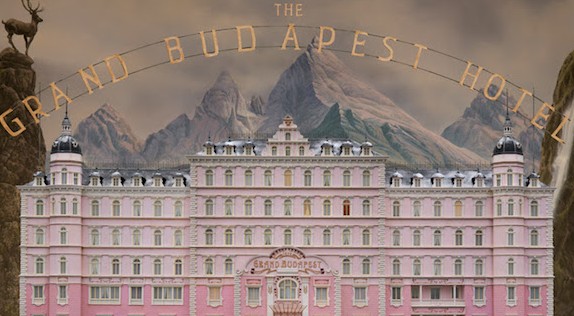Our story, rented from the Wes Anderson Library of Quirk and Imagination, begins with a trip to a cemetery. The physical book, true to Anderson form, opens to a chapter detailing an author’s first arrival at the Grand Budapest Hotel in 1968. Layered throughout these fictitious pages is a story about Zero Moustaga (F. Murray Abraham), his adventures with the conceriege Gustave (Ralph Fieness), and how he obtained the Budapest Hotel.
Welcome to the sophisticated interior of Anderson’s mind. To understand the inner workings, it is essential to read the manual of Anderson’s precocious board game. The Grandbudapest Hotel is structured like a Clue-Candyland hybrid. In fact, many elements in Budapest are similar to the childhood games. Both are woven around a storybook plot with a race to the finish (in this case hotel). The pieces, or Anderson’s actors, are always the same even though they can preform different actions (different characters movie to movie). The winner is predetermined in the beginning, since the film is told in a murder-mystery flashback. The color palette of both are heavy on pastels and influenced by sweets, leaving the viewer hungry and happy.
Perhaps it is best to equate this film to making a French macaroon. The Anderson recipe calls for the ubiquitous casting of Jeff Goldblum, Edward Norton, Harvey Keitel, Bill Murray, Bob Balaban, Tilda Swinton, Owen Wilson and Jason Schwartzman. It is also detrimental to nod to Ralph Fiennes’ acting which excels in the Andersdersonian utopia. These cookiecutter characters fit perfectly into the Mendel Bakery in Grandbudapest. Though their confection are commendable (specifically Swinton’s with heavy prosthetics), the sweetlycolored pallet does not lean on the actors for performance but rather for additional backdrop.
Those who are not a fan of Anderson’s gratuity might find this film nauseating. The laissez-faire plot revolves around Mr. Mustapha’s character telling his nostalgic tale of his time at the Budapest Hotel. The backdrop of the film is serious and historical (flashback to 1932), but in true Anderson form, the the aesthetics are light and glamorous.
Grandbudapest is designed for any fan of the zany auteur. Anderson takes elements previously seen in his other films to new heights in terms of mise-en-scene. The camera movements are motivated by Anderson’s showy hand and circumnavigate the central story to fixate on the darker underbelly typical in Anderson’s films. The comedic elements of Grandbudapest are juxtaposed with dark enigmatic moments, like Willem Dafoe’s turn as a crazed bodyguard. These elements are not unique to the Anderson viewer, but still equally as enjoyable. Even if you are not used to Anderson’s style, this film is worth seeing. The aesthetics alone will transfix the viewer even if the plot lags at certain points, and leaves them wanting nothing more than a macaroon. •









